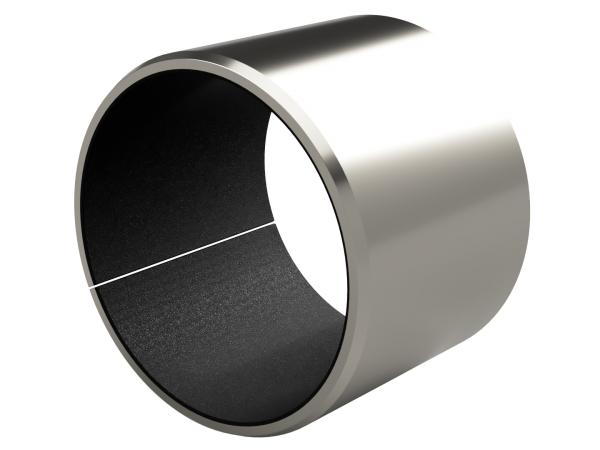MU Self-Lubricated Bearings




Multilayer bushing (dry Sliding Bearings) MU bearings are self lubricated material and are a three layer composite product.
- PTFE Modified antifriction surface layer 0,01 mm minimum thick (without lead, complying with the European Parliament’s “ELV” directive 2000/53/Ec);
- Porous bronze layer 0,20 - 0,35 mm thickness;
- Low carbon steel supporting strip 0,50 to 2,70 mm thick depending on the size of the bush. The steel is plated for corrosion protection (Tin or Zinc 2 - 8 μm).
Operating Conditions
-
DRY -
OIL -
GREASE -
WATER -
PROCESS
FLUID
Please, fill this form for getting current Pricesheet and/or Drawings in DWG format. We will send you all files on your email.
All fields, which marked by an asterisk (*), are required.
Thank you for your interest in our company.

Characteristics
MU structure combines in the best way the mechanical strength of the steel, the bronze thermal conductivity and PTFE low friction. The performance given without lubricants are the following:
- Working surface acceptable specific static pressure: Max 250 N/mm2;
- Working surface acceptable specific dynamic pressure: Max 140 N/mm2;
- Maximum sliding speed (dry): 2,5 m/s (500 fpm);
- Maximum sliding speed (oil): 10 m/s (2000 fpm);
- Working temperature from: -200°C to +280° C (-328°F to +536°F);
- Friction factor from 0,02 to 0,20;
- Clear fluids like oil or water permit higher values for speed and specific pressure;
- Friction factor not affected by “stick - slip” effect;
- High chemical resistance to industrial fluids and gases (we recommended to make previous test for new application / project).
Special Items
Apart from bushings ISO 3547 (DIN 1494) and thrust washers, the MU can be supplied as many other technical items, between them we indicate the followings:
- Bushings and washers at customer request measures;
- Counter - roller bushings with the sliding surface on the outside diameter;
- Special items at customer’s drawing.
Performance
MU bushing service life depend mainly from the load factor P x V (N/mm2 · m/s). Practical cases have shown that a working load factor of 2.5 to 3,6 (N/mm2 · m/s) is admissible for short periods. Long service life are suited with load factors ranging from 0.2 to 1.8 for continuous movements and 0.1 to 0.9 (N/mm2 · m/s) for alternate movements.
Friction
MU friction factor principally depends from the specific load, the sliding speed and from the working temperature; very important it is also the material and the counter piece superficial degree of finishing.
| Sliding Speed V ( m/s ) | Specific Load P (N/mm2) | Friction Factor |
|---|---|---|
| up to 0,001 | 140 | 0,02 |
| from 0,001 to 0,005 | from 140 to 62 | from 0,04 to 0,07 |
| from 0,005 to 0,05 | from 62 to 11 | from 0,07 to 0,1 |
| from 0,05 to 0,5 | from 11 to 1 | from 0,1 to 0,15 |
| from 0,5 to 2,5 | 1 | from 0,15 to 0,2 |
Wear
During operation the MU bushing shows a first running - in phase when some of PTFE compound transfers on counter piece which normally is of steel alloy. Other counter pieces of stainless steel, chrome plated steel and hard anodised aluminium can improve MU service life. As counter piece have to be avoided bronze, aluminium, phosphatized and nickel plated steel to optimise MU durability surface roughness must not exceed 0.4 um. Where possible MU bushing preliminary tests have to be carried out to make sure about the influencing factors of each application; our technical department is willing to supply additional information and data request.




